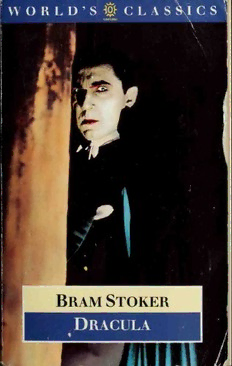
Dracula PDF
Preview Dracula
O R 1 '# Bram Stoker Dracula m llllli THE WORLD'S CLASSICS DRACULA Bram Stoker was born in Dublin in 1847. He was christened Abraham after his father, a civil servant inDublinCastle. In1863,afterasemi-invalidchild-hood, he entered Trinity College, Dublin, where he achieved notable success not only as a mathematician and in the PhilosophicalSocietybutalsoasanathleteAftergraduat- ing, and during a ten-year period as a civil servant, he made the acquaintance of Henry Irving, and between 1878 and 1905 he acted as Irving's touring manager and secretary. Hecametoknowallthemajortheatricalmen andwomenofthe age. He diedin London in1912. Bram Stoker's first book was The Duties ofClerks of PettySessions inIreland(1878). He wenton towrite short stories andseveral novels, ofwhich Dracula (1897) is the bestknown; as well ashis PersonalReminiscencesofHenry Irving(1906). A. N. Wilson is the authorofseveralnovels as well as a study ofSir Walter Scott, TheLairdofAbbotsford(1980), TheLifeofJohnMilton(1983),andanacclaimedbiography ofTolstoy. THE WORLD'S CLASSICS BRAM STOKER ^racula WithanIntroductionandNotesby A. N. WILSON Oxford NewYork OXFORD UNIVERSITY PRESS I OxfordUniversityPress, WaltonStreet, Oxford0x26DP Oxford New York Toronto Delhi Bombay Calcutta Madras Karachi PetalingJaya Singapore HongKong Tokyo Nairobi DaresSalaam CapeTown Melbourne Auckland andassociatedcompaniesin Berlin Ibadan OxfordisatrademarkofOxfordUniversityPress Introduction, Bibliography, Chronology, Notes, © A. N. Wilson, 1983 Thiseditionfirstpublished1983asa World'sClassicspaperback Reprinted198s, 1986{twice),1987, 1988, 1989, 1990(twice),1991(twice), 1992 (twice) Allrightsreserved. Nopartofthispublicationmaybereproduced, storedinaretrievalsystem, ortransmitted, inanyformorbyanymeans, electronic, mechanical,photocopying, recording, orotherwise, without thepriorpermissionofOxfordUniversityPress Thisbookissoldsubjecttotheconditionthatitshallnot, byway oftradeorotherwise, belent, re-sold, hiredoutorotherwisecirculated withoutthepublisher'spriorconsentinanyformofbindingorcover otherthanthatinwhichitispublishedandwithoutasimilarcondition includingthisconditionbeingimposedonthesubsequentpurchaser BritishLibraryCataloguinginPublicationData —Stoker, Bram Dracula. (The World'sclassics) 1. Title 82j'.8[F] PR6037.T617 ISBN0-19-281598-9 LibraryofCongressCataloginginPublicationData Stoker, Bram, 1847-1912. Dracula. (The World'sclassics) Bibliography:p. I. Wilson,A. N. (1950- ). II. Title. PR6037.T617D7 1983 823'.8 82-22324 ISBN0-19-281598-9(pbk.) PrintedinGreatBritainby BPCCHazellsLtd Aylesbury, Bucks. Introduction vii FurtherReading xxi A ChronologyofBram Stoker xxiii "HP APTTT A I ExplanatoryNotes 379 INTRODUCTION Cases ofvampirism may be said to be in our time a rare occult phenomenon. Yet whether we are justified in supposing that they areless frequenttoday than in pastcenturies I am farfrom certain. One thing is plain: - not that they do not occur but that they are carefullyhushedupandstifled. So wrote the Reverend Montague Summers, the leading English authority on the subject, in The Vampire in 'Europe (1929). Since his day, the vampires have been so successful in hushing up their nocturnal operations that many ofus would behardputtoittonamemorethanahandfulofyoungvirgins in our acquaintance who have been bothered by thirsty visits from the living dead. Vampires, as Montague Summers implied, come and go. There are more in Hungary (for example) than have ever been spotted in England. They seemed to be thicker on (under or over) the ground in the eighteenth century than in the seventeenth or the twentieth. It was only in 1824 that the Laws of England felt safe enough to allow suicides to be buried without the customary safeguard ofdriving a wooden stakethroughthevictim'sheart(topreventthecorpseturning into a vampire). Ninety years before, in 1732, Herbert Mayo described a vampire being dug up in Belgrade in his book On truths Containedin Popular Superstitions. When disinterred, itleanedtooneside, theskinwasfreshand ruddy, thenails grown long and evilly crooked, the mouth slobbered with blood from its last night's repast. Accordingly a stake was driven through the chest of the vampire who uttered a terrible screech whilst blood pouredinquantitiesfromthewound. Thenitwas burnedtoashes. Moreover, a number ofother persons throughout the district had beeninfectedwithvampirism. Ofthefactstherecanbenoquestion whatsoever- the documents are above suspicion, and in particular the mostimportantofthese, which was signed by three regimental surgeons, and formally counter-signed by a lieutenant-colonel and sub-lieutenant. TheBelgradeVampireis onlyonementionedbyMontague Vm INTRODUCTION Summers's first book on the subject (1928). It is a disturbing work, for, as Summers shows, the evil eflfects ofthe vampire extend far beyond their immediate victims. As well as the living dead (their ectoplasm escaping through holes in their graves and assuming bodily shape once above ground) there are ofcourse the imitators those who have not yet died and : therefore have no excuse for their unwholesome cannibalistic tastes. Summers recounts in punctilious detail the story of Fritz Harmann of Hanover, who was beheaded on 15 April 1925. Harmann was, before his decapitation, a homosexual, and his victims were exclusively adolescent boys. At least twentyofthemwerenamedatthetrial,ashavinggonemissing some time between Harmann having bitten their throats and his selling mysterious carcases to a butcher's shop near the railway stationinHanover. Itwill neverbe knownhow many of the *mannliche Prostituierten' of Hanover's red-light district ended up in Harmann's apparently very palatable sausages. Butallhad died, accordingto theclericalchronicler, in the same way. 'The violent eroticism, the fatal bite in the throat, are typical of the vampire.' Summers believed, with Havelock Ellis, that the motive of sexual murders *is nearly always to shed blood and not to cause death'. Sadly believable as that may be, what ofthe vampire in the morecomfortingconfinesofpoetry,thedrama,andthenovel? It is striking, again as Summers observed, how little there is of the vampire in literature. German superstition is full of tales ofblood-sucking. And it was German superstition, very largely, which fired the imagination of *Monk' Lewis; to a slightly lesser extent the much richer imagination of Charles Maturin.Theyconceive,betweenthem,ofalmosteveryhorror which a haunted Gothic castle, or a Spanish convent riddled with sadists, or a graveyard at midnight could provide. Banditry,lunacy,sexualperversion,and tortureenlivenalmost every chapter they wrote; but they did not choose to write about vampires. It was not until 1819, indeed, when John Polidori published The Vampjre, that the idea seems to have got itself into English fiction. Polidori had cribbed it from Byron,whosepublisher,JohnMurray,furiouslyissuedtheorig- inalasafragmentinthesameyear.Neitherisparticularlygood. The first really extended treatment of the theme is Varney
